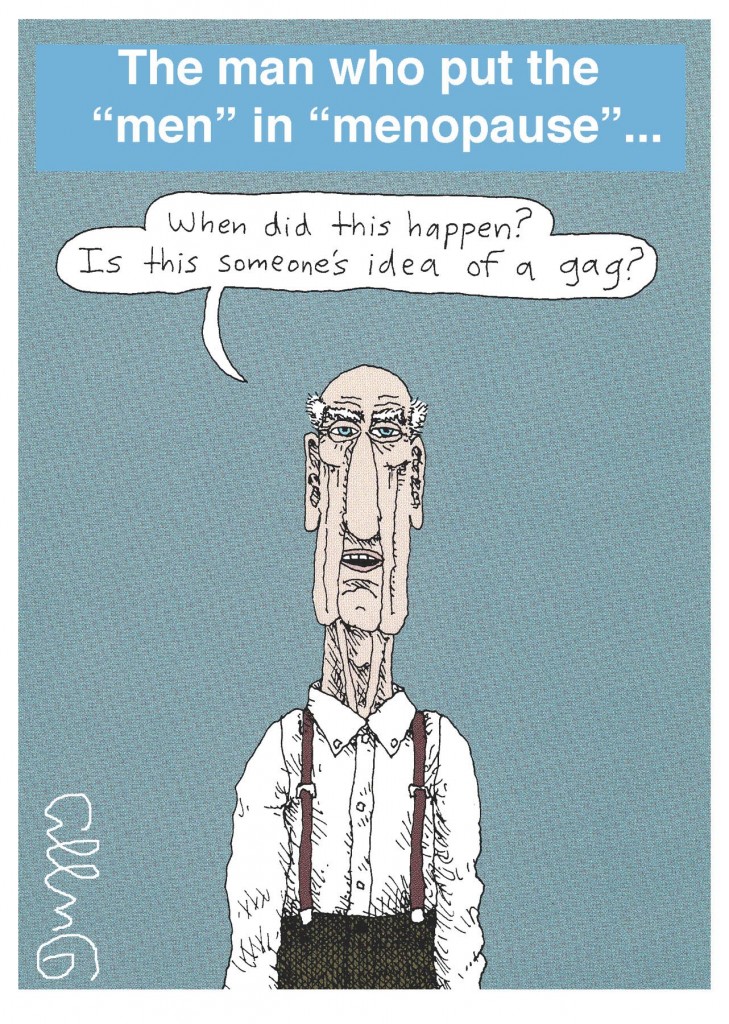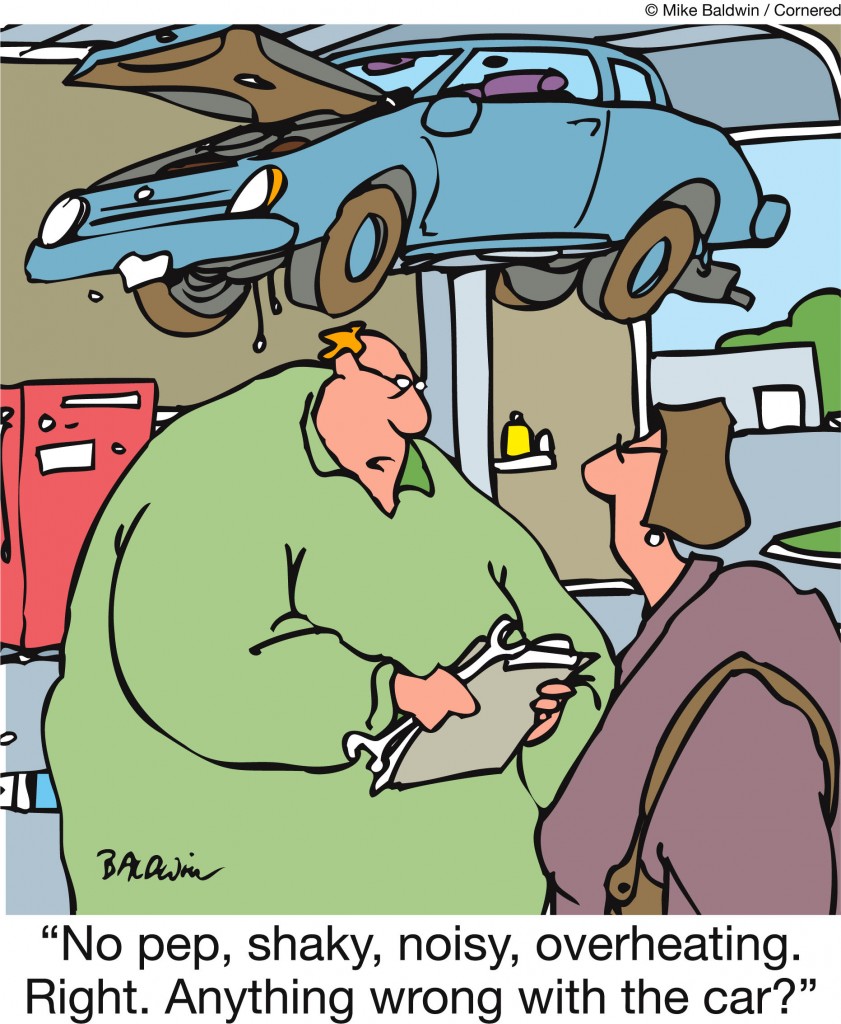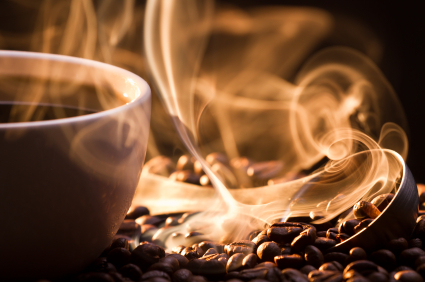Who put the men in menopause? Men!
Who put the ‘men’ in menopause?
Would you believe men?!!!
You must think I am bordering on insanity. But new evolutionary research (published in the June issue of PLOS Computational Biology) posits that cause of menopause is men. You read that correctly; men.
Various explanations have been proposed to explain why menopause, occurs, e.g. the grandmother theory, which assumes that as women enter their post-reproductive lives, they are better able to care for their offspring’s children or the evolutionary tradeoff hypothesis, which suggests that menopause is a tradeoff between future production of females and enhanced offspring survival.But what about the concept of mating and ‘mate choice?’
Mind you, I am venturing into geeky science territory here but briefly, researchers created a computer model and simulation and found the following:
A lack of reproduction has led to menopause.
That is, over time, human males started to display a preference for younger women in selecting their mates and in turn, “stacked the Dawinian deck” against continued reproductive abilities in older women. In other words, natural selection; only this time, it’s gender over nature plus nature over nature. The researchers say that their model not only shows that men had a shift towards preferring younger females, but that certain female-specific mutations led to detrimental effects on female fertility – effects such as an increase in certain hormones and the cessation of ovulation altogether.
The researchers say that infertility in women has not evolved but rather “over time, competition among men of all ages for younger mates has left older females with much less chance of reproducing,” adding that “natural selection is only concerned with the survival of the species through individual fitness so they protect fertility in women while they are most likely to reproduce.” The rub here is not only does fertility cease to exist but women are left with a host of health problems as a result. Yikes!
Interestingly, the lead investigator, Rama Singh, points out that if women had historically been the ones to select younger mates, the situation would have been reversed, with men losing fertility.
Besides the obvious conclusion, that is, men put the men in menopause, what else can we draw from this hypothesis. For one, if male selection drove the ‘pause, it isn’t inconceivable that the paradigm could ultimately be reversed. But that’s science fiction for another planet and another time.
On a side note? The term male menopause is a bit rhetorical, don’t you think? That’s a topic for another day.
Read More
Wednesday Bubble: Got a fix for that?
No bursting going on this week! Need a quick fix? Somehow, Jiffy Lube might not be the wisest choice.
See you Friday. With some big news!
Read MoreScents and sensibility…aromatherapy and your mental health
 Scents? Or Sensibility? Can aromatherapy boost the psychological benefits of therapeutic massage?
Scents? Or Sensibility? Can aromatherapy boost the psychological benefits of therapeutic massage?
I am a huge proponent of aromatherapy also though I have never been convinced one way or the other of its medicinal value. I simply like good scents; I find that they can energize or relax, boost endorphins or calm nerves. And yet, one thing that I did not realize is that aromatherapy massage is the most widely used complementary therapy in nursing practice — legitimized largely by its role in holistic nursing — and is recognized by the US State Boards of Nursing. There are data that suggest that aromatherapy may help improve anxiety, depression and mood swings, which is interesting since mood swings and depression are common among some women going through menopause. And, massage has been reported to be helpful in ameliorating certain symptoms, including insomnia.
So, what exactly is aromatherapy?
Aromatherapy refers to the use of essential oils, extracts if you will, that are distilled from roots, seeds, leaves or blossoms of plants to promote physical healing or enhance overall wellbeing. The practice has been used for roughly 6,000 for therapeutic purposes. While experts are not certain how aromatherapy works, some believe that it works through smell receptors in the nose that communicate directly with the brain.
Currently, researchers are reporting that when added to therapeutic massage in menopausal women, it may help to reduce the burden of psychological symptoms. In fact, when they compared the effects of twice weekly, 30 minute aromatherapy massage sessions to the same type of massage but an odorless oil and to no intervention at all, that is exactly what they found.
For the purpose of this four week study, researchers used an oil that consisted of safely diluted proportions (4:2:2:1 ratio, respectively) of:
- lavender — known for its sedative properties and ability to promote calm
- geranium — commonly used for menopause
- rose — useful for reducing stress and targeting menopause and related hormonal issues
- rosemary — known to improve circulation and exhaustion
Evening primrose oil — an oil that is often used as a carrier (pressed rather than distilled) oil to enhance the effects of the essential oils.
A certified midwife (who also held a massage and aromatherapy certification) conducted the massages at the same time daily; oil was applied with hands using clockwise circular movements with light pressure and the participants lay face down. And, the researchers used two scientific measures both at the study’s start and end to evaluation depressed mood, irritability, anxiety, physical/mental exhaustion and impairments in memory and concentration. To reduce bias, face to face interviews were carried out rather than relying on recall and self administered questionnaire.
The findings? Both aromatherapy therapeutic massage and regular therapeutic massage appeared to have positive effects on psychological symptoms. However, somewhat higher average reductions in severity scores were seen in women who had the aromatherapy massage. And compared to women who didn’t receive any treatment whatsoever, aromatherapy massage had significant effects on depression, irritability, anxiety and physical and mental exhaustion.
It’s virtually impossible to tease out the emotional benefits alone of having massage or aromatherapy massage; being touched warmly and gently tends to boost overall wellbeing. However, from a scientific standpoint, aromatherapy massage therapy in a controlled environment appears to boost the effects of regular massage.
Yesterday, I put this theory to test. I felt a heck of a lot better but not necessarily due to the scents. I’m opting for sensibility on this one. Meanwhile, what are your thoughts on aromatherapy?
Read MoreRe-spilling the beans on coffee and caffeine
With all the attention on coffee this week, I thought I’d re-spill the beans with a note of caution: not every cuppa is created equal. It seems fairly intuitive, doesn’t it? Afterall, the gut wrenching motor oil that you pick up at McDonalds is hardly equal to the made to order brew that is sold at one of my local favourites – Peregrine Espresso.
Recently, I ran across an editorial in the online edition of Maturitas that provides a deeper dive into coffee and what we, as consumers, are actually drinking every time we purchase a cup in a coffee shop. And the data may astonish you because while the serving sizes of espresso are within similar ranges, the caffeine content varies as much as two to almost six-fold. And let’s face it; most of us drink coffee for the taste. And for the caffeine effects.
However, as the authors point out, when it comes to commercially purchased coffee, it’s almost impossible to determine how much caffeine one is actually ingesting. This makes it difficult to stay within guidelines outlined by the International Food Council that suggest that moderate intake of caffeine equates to roughly three 8 oz cups a day, or 300 mg per day. (FYI: on average, it takes 5 hours for most adults to metabolize and excrete about half the caffeine consumed — in scientific circles, this is called “half-life”). And while this may seem unimportant to most, too much caffeine not only promotes insomnia or feeling jittery, but in amounts over the moderate intake level, may be downright dangerous for pregnant women (whose fetus can’t metabolize the purine akaloid in coffee). On the flip side? Regular coffee intake can help control gycemic levels (so long as you don’t add sugar), reduce the risk of depression and reduce cognitive decline, especially in women.
So, what do you need to know before you buy that next cuppa?
- Different coffee shops used differing amounts of coffee to prepare their coffee drinks.
- Barista methods vary from shop to shop and factors like water temperature, steam, time brewed, etc, all play a role.
- If you are a latte or cappuccino lover, your espresso is diluted but to what extent is a mystery.
- Beans are harvested, roasted and ground differently from one cup to the next.
The authors say to have no fear but to insist on “good quality, 100% arrabica beans,” and to start paying attention to the process. I think that this advice is a bit far fetched because short of being one of ‘those’ customers, I don’t see how one can control or demand. Starbucks is Starbucks, right? BTW, while the analysis was conducted in Scotland, Starbucks espresson had the lowest level of caffeine per serving — only 51 mg, which begs the question, what are you paying for when you drop $5 on the double espresso?
So, “what’s in your cup?” It’s fairly intuitive that a few visits to the same coffee shop will yield a lot of non-scientific answers; if two espressos cause a whole lotta jitters, have one the next time. That aside, I suggest a home brew to take all questions off the table and help insure that you are getting all of the benefits that you can out of every cup.
Read More
Wednesday Bubble: Sunscreen and Skin Aging
I am bursting a big bubble today. The topic? Aging skin. Lord knows it’s a common theme among the women I know. And many women spend thousands (if not tens of thousands) of dollars on creams, lotions, botox, fillers, face lifts and the like to prevent wrinkles, make them disappear or preserve what they have.
Among the many culprits linked to aging skin, cumulative sun exposure is the worse. Ultraviolet (UV) light wreaks havoc directly on proteins and acids in the skin cells, impairs collagen and elasticity, and at its worse, promotes the development of skin cancer.
So short of spending thousands on the above, what can you do?
WEAR SUNSCREEN!
I can’t emphasize it enough.
Experts have been telling us for years that sunscreen can protect against the development of skin cancer. Guess what?! For the first time, researchers have shown the wearing sunscreen can also protect against skin aging. Moreover, a good sunscreen costs a heck of a lot less than costly cosmetic procedures that requires regular maintenance or endless surgeries to remove skin cancer patches.
In a newly published study appearing in the Annals of Internal Medicine, researchers assigned 903 adults under the age of 55 — most of whom were fair skinned and burned when exposed to acute sun — to two groups:
- Roughly half applied sunscreen, SPF 15, to their head, neck, arms and hands every morning and were asked to reapply it after spending several hours outdoors or after heavy sweating or bathing.
- Half were asked to apply sunscreen, SPF-15, at their discretion
- The study participants also received a daily beta-carotene capsule or a placebo
At both the study’s start and after about four and half years, the researchers took impressions of the back of every hand. To insure that the groups were ‘sticking with the program,’ so to speak, they were also asked to turn in suncreen and return the pill bottles for capsule counts every three months.
The findings? Well, at the start of the study, a little over half of the participants showed moderate photoaging; four years later, 49% had skin showing aging to the same degree. And, only the people who used daily sunscreen did not have a detectable increase in the severity of their photoaging. In fact, daily sunscreen users were 24% less likely than discretionary users to have experienced increased skin aging! The same findings were not seen among people with higher grade photoaging at the study’s start. And no differences were seen between beta-carotene and placebo tablet users. Importantly, the results did not appear to be linked to any change in time spent outdoors or in other sun protection methods.
The reason that the ‘under 55 set’ were chosen for the study is that the majority of their photoaging at this stage in their lives is due to sun exposures. So, the findings might not apply to adults older than age 55 whose aging skin is also due to other factors in addition to sun exposure. Still, the researchers say that a unit increase in photoaging grade is related to a visible deterioration in skin texture and an increase in visible small blood vessels and pores on the face. It also correlates significantly with a risk for keratoses and skin cancer.
Still unknown is whether or not a sunscreen with a higher SPF would achieve even greater results. And there are a few scientific limitations to the study; for example, a third of participants did not have skin impressions taken at the study’s start (although the researchers argue that this did not appear to affect the results), and the study numbers were too small to conclude a true lack of benefit with beta-carotene. Yet, what is clear is pretty simple:
Wear sunscreen. Not only will it help to protect against skin cancer but, it also appears to yield a cosmetic benefit, preventing visible aging. That’s a win-win in my estimation!
Read More










